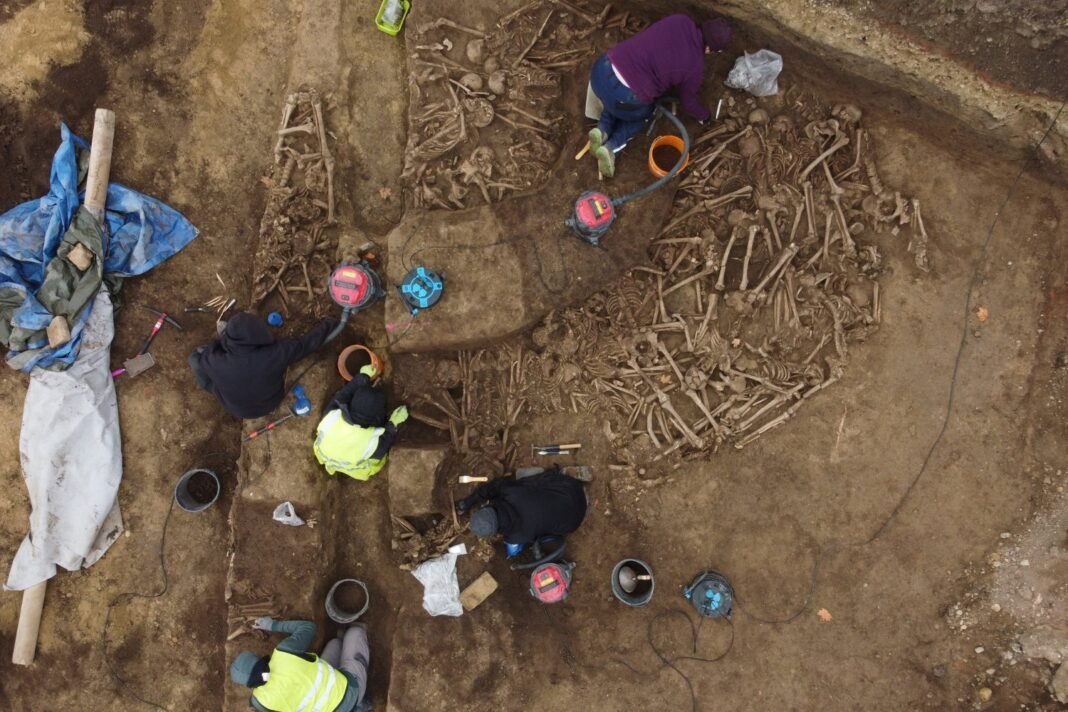Contents
Ancient Roman Mass Grave Discovered Near Vienna: Evidence of Battle with Germanic Tribes
A groundbreaking discovery in Vienna has unearthed a mass grave containing the remains of Roman soldiers, shedding light on a fierce battle between Roman legionaries and Germanic fighters near the Danube River, dating back nearly two thousand years.
Lead: In a stunning archaeological find during renovations of a sports field in Vienna, experts have uncovered a mass grave believed to be from the turbulent era of Roman military expansion. Discovered in October 2022, the site reveals the remains of approximately 150 individuals, likely Roman soldiers, who died in a confrontation with Germanic tribes near the Danube River. This historical evidence, validated by local archaeological experts, provides crucial insights into early conflicts that shaped Vienna’s origins and offers a rare glimpse into the city’s past.
Significance of the Discovery
The mass grave located in the Simmering district of Vienna holds significant archaeological importance, as it is the first direct evidence of an ancient battle along the Danube Limes, which was a crucial part of the Roman Empire’s eastern frontier.
– **Age of the Findings**: The remains, dating between the mid-first century and early second century CE, suggest a time of conflict as the Roman Empire expanded its reach.
– **Excavation Insights**: The site was uncovered by construction workers who were renovating a sports field, leading to a collaborative excavation by the Vienna City Archaeology Department and Novetus GmbH.
Expert Opinions and Analysis
Key experts have weighed in on the discovery, emphasizing its significance in both historical and archaeological terms.
– **Veronica Kaup-Hasler**, Vienna’s Executive City Councillor for Culture and Science, stated, “A true sensation in this regard is the discovery of a Roman mass grave in Simmering. This unique testimony allows us to look at the beginnings of our city’s history from a different perspective.”
– **Michaela Binder**, a senior anthropologist at Novetus GmbH, confirmed, “Based on the arrangement of the skeletons and the fact that they are all male remains, it can be ruled out that the site was connected to a hospital or similar facility, or that an epidemic was the cause of death.”
Unraveling the Evidence of Combat
Field analysis revealed that the remains belonged predominantly to young men, largely between the ages of 20 and 30, and exhibited injuries consistent with combat situations.
– **Condition of Remains**: The skeletons showed little evidence of infectious diseases and displayed remarkably good dental health, a rare feat in ancient times.
– **Signs of Trauma**: The injuries identified were sustained from weapons including daggers, spears, swords, and projectiles, affirming the violent nature of their deaths.
Artifacts Unearthed
In addition to human remains, numerous artifacts were recovered, providing additional context to the historical period.
– **Weaponry and Armor**: Artifacts included armor scales, lance tips, a helmet cheek piece, and a fragmented iron dagger.
– **Dating the Findings**: The iron dagger’s sheath, embellished with silver wire inlays, highlights its production during the early Roman Empire, further corroborating the dating of the grave site to the first two centuries CE.
A Rare Archaeological Insight
According to Kristina Adler-Wölfl, head of the Vienna City Archaeology Department, this discovery is particularly rare since cremation was more common during this era.
– 🔑 **Historical Context**: “Since cremations were common in the European parts of the Roman Empire around 100 AD [CE], inhumations are an absolute exception. Finds of Roman skeletons from this period are therefore extremely rare,” Adler-Wölfl emphasized.
This rare opportunity to study this mass grave allows historians and archaeologists to connect historical narratives with physical evidence, thus enhancing our understanding of the Roman Empire’s military engagements.
The Broader Historical Impact
The conflict and subsequent discovery are expected to hold strategic implications for understanding Roman expansion efforts.
– **Potential Causes for Expansion**: The battle date matches the period of Emperor Domitian’s reign, suggesting military engagements on the empire’s frontier were influential in shaping the future of the region.
– **Formation of Vindobona**: Archaeologist Martin Mosser noted, “The finding may thus reveal the beginning of Vienna’s urban history,” indicating that this locale’s military significance led to its evolution from a small base to the prominent settlement known as Vindobona.
Conclusion: The discovery of this ancient mass grave in Vienna not only unveils significant insights into the city’s early military history but also serves as a testament to the complexity of Roman interactions with Germanic tribes. As excavations continue and further analyses are conducted, researchers hope to draw even more connections between this ancient conflict and the burgeoning history of modern Vienna.
Keywords: Roman mass grave, Vienna archaeology, ancient battles, Danube River, Germanic tribes, Roman Empire history, Vindobona, historical discoveries.
Hashtags: #RomanHistory #Archaeology #Vienna #MassGrave #AncientBattles #DanubeLimes #HistoricalDiscovery #CultureAndScience
Source link




